Part 1: How is gender reflected in “new music” and classical music?
What is “new music?” Why do most orchestras and chamber groups play such a small percentage of it? Why is there so little diversity in the identities of the composers we perform?
Before I was part of UMS’s Marketing Team, I studied double bass and clarinet at the University of Michigan. Most days, I toed the line, practicing standard repertoire to prepare for auditions. While doing so, I realized that every composer I learned about was dead. Every composer was a man. Every composer was white. Every composer was from Europe. Once in a while, I would play something not on the standard audition list! I’d play something new — and by that I mean, written after the 1950’s. Even then, most of the composers I come across were white men from Europe or the United States.
I wanted to find out about other women’s experiences at the University of Michigan, so I asked several recent graduates and current students to share their thoughts about diversity in the arts, and about performing, creating, and listening to new music.
Annika Socolofsky, vocalist, fiddler, and composer
What makes music “old” or “new?”
I think there’s often this dichotomy created around the concept of “old” and “new” music. But in reality, time is continuous–there is no old and new, there’s just music. And I think that maintaining that notion of a dichotomy only hurts music. It says, “These old guys are from another world, another time,” and it simultaneously says, “This new music is different. It doesn’t have melodies, harmonies, or meter in the styles that I am used to.” Of course there is no point in time that labels something old and something else new. Often times Schoenberg, Webern, Stravinsky are presented as “new music,” but Schoenberg’s Pierrot Lunaire is over a century old! Why is it being presented as new? Is it because it’s dissonant? Decidedly non-romantic?
I think the music being created today is more diverse and genre-obliterating than ever before. It’s a really exciting time to be creating because we are not bound to the notion of harmony or melody or rhythm in the way that composers once were.
Noniko Hsu, flutist
Do you have a preference for “old” or “new” music?
I think that for performers and audience members alike, playing old and new music is equally important. I’m always excited to play music that is inspiring, tells the audience a story, and means something to me on a personal level. In the end, both new and classical music were created by composers to inspire people through all ages. The problem I see with the lack of diversity in the identities of composers we perform is that we mistake what the listeners really want. People go to a concert for an experience; it can be comforting, challenging, or moving, and how we achieve that as performers can vary. We sometimes mistakenly think that we can easily satisfy music listeners by playing them music they already know and love. This can be true in some ways, but if we can start from the point of view of storytelling, we will have a more colorful palette to play with in terms of which composers we choose!
Mackenzie Sato, percussionist and teacher
What is the role of a K-12 teacher in presenting a broad range of pieces to their classes?
As a band and orchestra teacher, repertoire is really the cornerstone of my performance curriculum. However, only recently have I become comfortable breaking away from the classical music “canon” and teaching music that incorporates not only new, 20th century composers, but also late classical composers of color and female composers.
I think that composing music is a kind of culmination of experience, so to introduce new experiences to my classroom allows my students to ask questions we may not otherwise cover. For example, when one student pointed out that we only played one piece by a female composer that year, she asked why we didn’t play more pieces composed by women. I asked her to name 3 famous women composers. Not surprisingly, she couldn’t. This opened a long conversation about the different kinds of expectations, opportunity, and identity validity society has for men and women, for whites and people of color.
So after a little research, my students found that as time has moved forward, more identities–more experiences–have appeared in the compositions in recent years. Do they like all of their pieces? No, not necessarily (20th century music has allowed us to talk about the trajectory of music theory and history quite nicely). But, as they are all students of color, they’re interested, because music is starting to welcome other identities besides white men. They begin to see themselves in the music in a different way. And that certainly doesn’t mean that we don’t love to listen to Bach or Brahms or Wagner, but it does allow some the perspective to enjoy different kinds of music, which is really all I can hope for as a teacher.
Pavitra Ramachandran, vocalist
Can you share a moment when you learned something new about “new music?”
I used to be incredibly hesitant about performing new music. I always thought new music was mostly atonal, and I am someone who loves a melodic framework that a composer expands upon. However, when I heard Songs from Letters by Libby Larson, I was awestruck. The work may be atonal, but the modal structure of the piece evoked a nostalgic expression and such intense emotion. As described by the title, in this work Larson borrowed text from letters written by Calamity Jane, a cowgirl from the Wild West who was separated from her daughter. These letters were composed to connect with her daughter and retell her life story. I sang this piece at my graduate recital and worked very hard to embody her powerful struggle. The response was overwhelming. My advice to those wary of new music is: “You never know until you try.”
Kathryn Zamarron
As a woman of color, how do you reconcile that a majority of the music you perform is created by European men?
Sometimes I actually like music from the canon a bit more than contemporary music. Brahms, Mahler, Verdi, and French impressionism speak to me, emotionally, in a way much modern music doesn’t. The leading role of melody and harmony — as opposed to story painting, sound effects. or dissonance — connects to things I feel but don’t know how to say.
When they were composing, many of these composers were writing about very serious life issues: death, exile, political extremism. Their works were positive outlets for the frustration, anger, and depression of ignored, marginalized, and persecuted community members. Their experiences parallel the highly polarized political and cultural situation I find myself living in today.
By participating in the classical music scene, I am actively rejecting and disproving the notion that classical music is “white people music;” my participation says “I am here,” and it demands the kind of social responsibility and diversity outreach that other institutions have been working on for far longer than mainstream classical music has. If I’m not in the audience, the music school, or the sheet music store then they don’t have to worry about who is on their stage, faculty, or shelves. Who else will call on them to address the absence of people who look like me?
Tsukumo Niwa, oboist
Why do you want to play new compositions or styles of performance?
Composers tell narratives through their music which performers interpret and retell. As someone who engages in social justice work as well as classical music, I always struggle with the reality that almost all of the main ‘narratives’ for my instrument are provided by dead white European men. Even though I appreciate the beauty of their music, I also find myself not wanting to recreate the stories of eurocentrism and (cis)sexism which are already too ubiquitous in our daily lives. That’s why I want to perform new compositions, and learn new styles of performance. I want to tell my own stories and enhance the stories of others who are often silenced or ignored.
This spring, for a taste of “new” music, Roomful of Teeth (April 12, 2017) or the Calidore String Quartet (February 5, 0217). Both feature music created by composer and vocalist Caroline Shaw.
Artist Internships for 21st Century: 2015-16 Students
The fast changing environment of the 21st century poses new demands on artists. They must reach potential audiences in innovative and unexpected ways. To address these needs, the U-M School of Music, Theatre & Dance and University Musical Society (SMTD and UMS) launched a new student arts internship program for four SMTD undergraduate students in the summer of 2015. Chosen through a competitive application process, each student fellow interned for a minimum of five weeks between May and August 2015 with a professional dance, theater, or music ensemble that UMS planned presented during the 2015-16 season. The program will continue and we’re currently selecting fellows for next season.
Meet the students
 Tsukumo Niwa worked with the theater artist Taylor Mac and the production company Pomegranate Arts. See photos from her internship and watch behind the scenes video.
Tsukumo Niwa worked with the theater artist Taylor Mac and the production company Pomegranate Arts. See photos from her internship and watch behind the scenes video.
 Evan Saddler worked with the New York Philharmonic. See photos from his internship and watch video highlights from the orchestra’s residency in Ann Arbor.
Evan Saddler worked with the New York Philharmonic. See photos from his internship and watch video highlights from the orchestra’s residency in Ann Arbor.
 Christina Maxwell worked with the Mariachi Vargas de Tecalitlán. See photos from her internship and watch as she performs the classic Mariachi song “Besame Mucho.”
Christina Maxwell worked with the Mariachi Vargas de Tecalitlán. See photos from her internship and watch as she performs the classic Mariachi song “Besame Mucho.”
 Meri Bobber worked with Hubbard Street Dance Chicago. See photos from her internship and read her essay about the choreography of William Forsythe.
Meri Bobber worked with Hubbard Street Dance Chicago. See photos from her internship and read her essay about the choreography of William Forsythe.
Interested in more? Explore internship experiences from past seasons.
Student Spotlight: Embedded with Taylor Mac and Pomegranate Arts
Editor’s note: As part of the UMS 21st Century Artist Internships program, four students interned for a minimum of five weeks with a dance, theater, or music ensemble part of our 2015-2016 season. Tsukumo Niwa is one of these students. This summer, he was embedded with the artist Taylor Mac and the production company Pomegranate Arts.
Below, Tsukumo shares her travel stories in New York City and beyond ahead of Taylor Mac’s performance in Ann Arbor on February 5, 2016.
This summer, through the UMS and U-M School of Music, Theatre & Dance 21st Century Artist Internship program, I had a chance to work closely with Taylor Mac and Pomegranate Arts in New York City.
A little bit about myself: I’m a junior majoring in Oboe Performance and International Studies. As such, theater arts – let alone drag performances – are a bit out of my specialty area. When I was first introduced to Taylor’s work, however, I was immediately intrigued by Taylor’s commitment to inclusivity, especially in terms of LGBTQ+ identities, and judy’s beautiful presence on stage with glittery and flashy costumes and make up. (Taylor uses “judy” as a gender pronoun.) Because I dedicate a lot of time to social justice education as well as music, I wanted to see how arts and social justice ideas can meet.

Taylor Mac performs. Photo courtesy of the artist.
International Festival of Arts & Ideas
The first week of internship, I attended my first Taylor performance at the International Festival of Arts & Ideas in New Haven, Connecticut. Held each year on Yale University campus, this festival brings in world-class artists and thinkers across genres. This festival commissioned the 1996-2006 decades of Taylor Mac’s 24-Decade History of Popular Music will eventually become an epic show performed over 24 continuous hours (in Ann Arbor, Taylor will focus on the 1960s, 70s, and 80s). The section at the festival was called “Songs Popular in the Radical Lesbian Circuit.” It was the opening performance.
On the day of the performance, six musicians, the company tour manager, and I took the Metro North together from Grand Central to New Haven. Some passengers noticed our gear, and asked if we’re musicians. Viva, the band’s “guitar goddess” interacted with her:
Viva: “Yes! We’re performing at Yale.”
Woman: “Cool, I might check it out! What kind of music?”
Viva: “It’s cabaret music from the 90’s.”
Woman: “Okay!”
Viva: “… popular with the radical lesbians.”
Woman: “…Oh.”
Viva: “You should totally come check it out!”
Woman: “Okay, I’ll try…?” *quickly escapes the scene*
While this woman wasn’t in our audience, we had a really good turnout, including donors in VIP seats with their jaws dropped as they experienced Taylor for the first time. We heard that one of the festival founders – a woman in her 80’s – attended the performance and left the house “glowing.” Almost everyone from Pomegranate Arts (the management company working with Taylor Mac) came to see the performance and to support Taylor. The support and reactions from the audience added to the energy of the performance by Taylor and judy’s band.
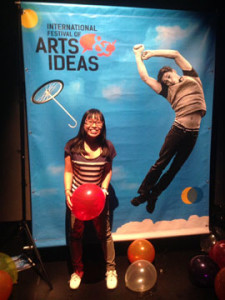
Me at the after-party, with performances by drag queens and dance music from the 90’s. It was fun!
Projects at the Pom Office
When I wasn’t at Taylor’s performances, I worked at the office of Pomegranate Arts, an independent management company that manages contemporary artists such as Sankai Juku and Philip Glass (both are familiar to the UMS audiences! Sankai Juku return this season October 23-24, 2015). With only 6 employees, it’s a small yet strong group that organizes shows and tours from start to finish.
With the help of my mentors, Linsey and Katie, I made a prototype of the project book for Taylor’s “A 24-Decade History of Popular Music.” Since “A 24-Hour History” is a huge project involving multiple parts, it’s necessary to keep them organized – costumes, stage directions, performance history, and song lists for each decade. Linda Brumbach, the founder and president of Pomegranate Arts, met with me to help me understand diverse topics what Pomegranate Arts is about, and what young artists like ourselves can do (watch for an interview soon!).
I also got to use my Japanese skills and helped to prepare visa documents for Sankai Juku company members. I can’t wait to finally see them in October!
Celebrate Brooklyn!
August 1, 2015 was the first time that Pomegranate Arts produced an outside show, and I was lucky to be a part of it. This was a huge one – 12 musicians on stage, 24 burlesque dancers strip teasing, and dozens of musicians from Brooklyn United Marching Band. About 2,000 people showed up for this free concert, ranging in age from toddlers to the elderly.
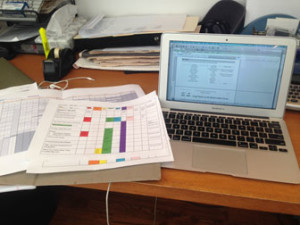
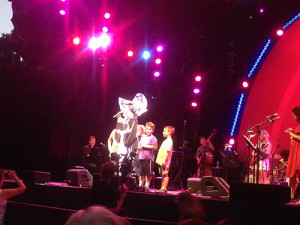
Photos: On left, my desk, with documents about “A 24-Decade History” project and project book on screen. On right, Taylor instructed these kids to (friendly) insult each other. The terrified look on their faces were priceless!
This was a huge day for me, too. As an intern, I was responsible for guiding all musicians and dancers backstage, hiring the videographer to film the rehearsal and mini interviews with artists, and just being available for anything the company needed. This was rewarding – I got to hear so many interesting stories from the musicians that have been working with Taylor for years, as well from as key people from Pomegranate Arts. One of my favorites was Machine Dazzle, the costume designer.
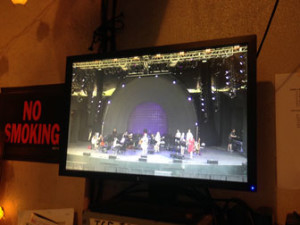
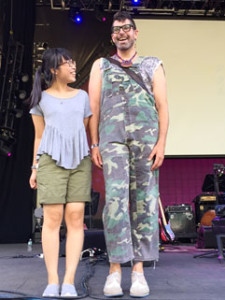
Photos: On left, dress rehearsal, seen through the backstage monitor. On right, Machine Dazzle, costume designer for Taylor Mac. He’s really tall. Or maybe I’m really short. Most likely both.
At this performance, a lot of things happened. Audience members were frequently brought to the stage and did various ridiculous things that Taylor asked them to do. They split up and shouted at each other, representing the pro-war and anti-war forces. The Brooklyn United Marching Band came on stage, 36 strong, and blew everyone in the crowd away.
Under Construction Series at the Park Avenue Armory
The final set of performances that I attended were totally different from the Celebrate Brooklyn! performance. They took place in the intimate and historic Park Avenue Armory, which accommodates artists that strive to create artworks that are difficult to present in traditional theaters and museums.
Since Taylor and Machine are resident artists at the Armory, they have access to one of the company rooms and store all the costumes and other materials related to “A 24-Decade History” project. It is really glittery, a bit messy, and awesome!
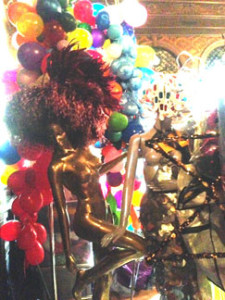
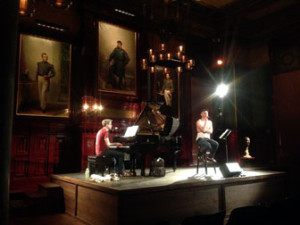
Photos: On left, just a few of the costumes living in the Armory! On right, the historic Board of Officers Room in the Armory. The walls are wooden, and acoustics are amazing for low-voice singer and piano! On piano is Matt Ray – the musical director.
There, they performed three decades that they have never performed before: 1776-1786, 1786-1796, and 1796-1806. Since these are near the dawn of US independence, many songs performed at these performances were patriotic. Taylor wore no costume for this performance; instead, some of the costumes were displayed stage-side so that the audience could imagine what this performance will look like as a finished work.
On the second night of this performance, during the “encore”, Taylor performed a song called “Pussy Manifesto” by Bitch and Animals from the 1996-2006 decade. During this song, he asks the audience to explore our various “pussies,” regardless of gender, in positive light. While Taylor asked the audience to explore our “mouth pussies” and sing the last phrase of the song, one audience member – a middle-aged man – showed strong discomfort. In response to this, Taylor said, “Whatever you’re feeling is appropriate,” meaning that audience members don’t have to necessarily like the performance. They could feel uncomfortable, disgusted, confused, or have any other emotion. Regardless of these emotions, as a theater artist whose art serves to challenge daily narratives, judy will have succeeded. This was quite a lesson for me.
Bringing This (Back) to Ann Arbor
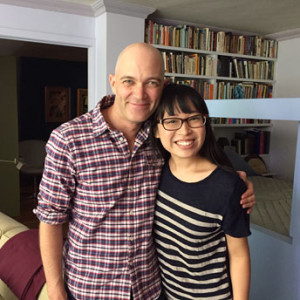 One of the biggest takeaways from this internship is that performances don’t always have to be perfect. Taylor calls judy’s performances “workshops,” implying that judy brings the performances closer to perfection through testing with the audience members. It takes courage to present something that you know isn’t perfect, and as a classical musician myself, I usually would not take this approach. However, now I feel more compelled than ever to show my imperfection, with the knowledge that I can get better with the help of audience and constructive feedback.
One of the biggest takeaways from this internship is that performances don’t always have to be perfect. Taylor calls judy’s performances “workshops,” implying that judy brings the performances closer to perfection through testing with the audience members. It takes courage to present something that you know isn’t perfect, and as a classical musician myself, I usually would not take this approach. However, now I feel more compelled than ever to show my imperfection, with the knowledge that I can get better with the help of audience and constructive feedback.
Speaking of audience, Taylor’s performances are full of audience interactions. Audience members can’t sit in their seats without doing something, whether it be manspreading, singing with Taylor and the band, or even sometimes slow-dancing with another audience member. Kids, elderly, moms, and LGBTQ+couples, and everyone in between get pulled to stage. Prepare to be challenged, and be comfortable being yourself.
Taylor Mac performs in Ann Arbor on February 5, 2016.
Interested in more? Explore more photo essays by students embedded with UMS artists.







